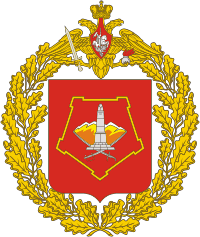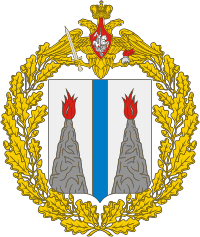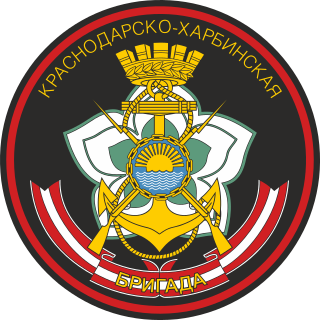
The Volga–Ural Military District was a military district of the Russian Ground Forces, formed on 1 September 2001 by the amalgamation of the Volga Military District and the Ural Military District. The headquarters of the Ural Military District, located at Yekaterinburg became the new headquarters of the merged district. In 2010 the District was merged with part of the Siberian Military District to form the new Central Military District.

The Far Eastern Military District was a military district of the Armed Forces of the Russian Federation. In 2010 it was merged with the Pacific Fleet and part of the Siberian Military District to form the new Eastern Military District.

The 10th Guards Uralsko-Lvovskaya Volunteer Tank Division, also known as the Ural-Lvov Tank Division, is a tank division of the Russian Ground Forces and part of the Moscow Military District's 20th Guards Army. The division traces its heritage back to 1943, during World War II. It is headquartered and based at Boguchar, 160 kilometres south of Voronezh, Voronezh Oblast.

The 90th Guards Tank Division was a division of the Soviet Army, and then of the Russian Ground Forces.

The 2nd Guards Tank Army was a large military formation of the Red Army and later the Soviet Army, now part of the Russian Ground Forces of the Russian Federation.
The 4th Rifle Division was an infantry division of the Soviet Union's Red Army, formed three times. It was first formed in 1919 from the remnants of the Lithuanian Rifle Division and fought in the Defence of Petrograd during the Russian Civil War. The division then fought in the Polish–Soviet War. In 1939, the division fought in the Soviet invasion of Poland. It fought in the Winter War from December 1939 and suffered heavy losses in the Battle of Kelja. After Operation Barbarossa, the division fought in the Barvinkove-Losowaja Operation and the 1942 Battle of Voronezh. It suffered heavy losses at Voronezh and was disbanded in November 1942. The division re-formed in 1943 and fought in the Bryansk Offensive, Gomel-Rechitsa Offensive, Lublin–Brest Offensive, Warsaw-Poznan Offensive and Berlin Offensive. It was disbanded in the summer of 1945. The division was re-formed a third time from the 160th Rifle Division and inherited that division's honorifics and awards. It became the 4th Motor Rifle Division in 1957 and disbanded in 1959.
The 270th Rifle Division was a Red Army infantry division formed twice during World War II, in 1941 and 1942.

The 28th Army was a field army of the Red Army and the Soviet Ground Forces, formed three times in 1941–42 and active during the postwar period for many years in the Belorussian Military District.

The Central Military District Russian: Центральный военный округ, romanized: Tsentral'nyy voyennyy okrug is a military district of Russia.
The 27th Guards Omsk-Novoburgskaya Red Banner order of Bogdan Khmelnitskiy Motorised Rifle Division was a Red Army rifle division in World War II which later became a Soviet Ground Forces motor rifle division.

The 40th Independent Krasnodarsko-Kharbinsky Twice Red Banner Marine Brigade is a brigade of the Russian Marines. It is based in Petropavlovsk-Kamchatskiy in the Russian Far East and has the Military Unit Number (v/ch) 10103. It is part of the North-East Group of Troops and Forces, a joint command directed by the headquarters of the Navy's Kamchatka Flotilla.
The 372nd Rifle Red Banner Novgorod Division was a division of the Red Army during the Second World War.
The 86th Rifle Division was an infantry division of the Soviet Union's Red Army during the interwar period, World War II, and the early postwar period, formed twice.
The 29th Rifle Division was an infantry division of the Red Army and later the Soviet Army.
The 213th Motor Rifle Division was a motorized infantry division of the Soviet Army. The division was based in Totskoye and existed from 1968 to 1991. In 1991, the division merged with the 27th Guards Motor Rifle Division.
The 168th Motor Rifle Brigade was a Russian Ground Forces motorized infantry brigade from 1994 to 1998. It was based in Borzya and traces its lineage to the 150th Motor Rifle Division, activated in 1973. The division became a training unit three years later and was converted into a district training center in 1988. In 1994, the training center became the 168th Motor Rifle Brigade.
The 62nd Motor Rifle Division was a motorized infantry division of the Soviet Army. It was originally formed as a mobilization division in 1972 but became a regular division months later. It became a storage base in 1989 and was disbanded in 1994.

The 336th Independent Guards Bialystok Orders of Suvorov and Alexander Nevsky Naval Infantry Brigade is a brigade of the Russian Naval Infantry, formerly part of the Soviet Naval Infantry.
The 12th Rifle Corps was an infantry corps of the Red Army during the interwar period and World War II, formed four times.
The 15th Guards Mozyr Red Banner Order of Suvorov Tank Division was a tank division of the Soviet Army during the Cold War that became part of the Russian Ground Forces after the dissolution of the Soviet Union.









